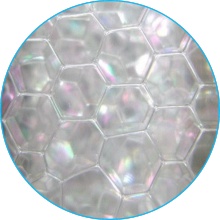Foams are non-equilibrium dispersions of a gas in a liquid, which typically is a surfactant solution. Foams are widely used in industrial applications and everyday products, e.g., for household, personal care, pharmacy, and food. However, the reason for their stability - or instability - is not yet understood in sufficient detail. The work of our research group is focusing on foam properties such as foamability, foam stability and foam drainage. The influence of the surfactant structure, the surfactant and salt concentration as well as of the pH-value on the foam properties are of particular interest. Our last studies show that hydrogen bonds between neighbouring surfactant molecules significantly enhance foam stability. The formation of hydrogen bonds between surfactant head groups at the surface gives rise to a short-range attractive interaction. This interaction may restrict the surfactant’s mobility while providing a more elastic surfactant layer which can counteract deformations. The capability of intersurfactant H-bond formation should be considered in the molecular design of foaming and anti-foaming agents. However, there is still a lack of data as regards the strength of the H-bond network and the cooperation of the molecular entities at the surface.
Current Projects
CO2-Switchable Additive and Surfactants
Staff: Robin Benedix, Prof. Dr. rer. nat. Cosima Stubenrauch
Innovative Cleaning Concept for Art Objects and Cultural Assets
Staff: Dr. Tamara Schad, Prof. Dr. rer. nat. Cosima Stubenrauch
Stability of Liquid Foams
Staff: Dr. Natalie Preisig, Prof. Dr. rer. nat. Cosima Stubenrauch



